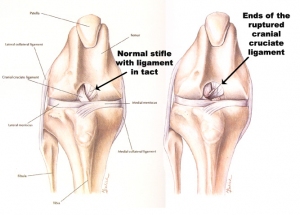
One of the most common injuries we see in small animal practice is a ruptured or partial tear to a ACL.
Dogs of all breeds may suffer these injuries,and we see young dogs right through to older dogs affected.In many cases a relative minor event can lead to the rupture,as simple as jumping off a couch or chasing after a ball. On the odd occasion we may have a dog yelp but usually there is no outward sign of pain,just a limping dog often barely toe touching his leg to the ground. Rest does not seem to improve the limp much and if suspicious a visit to your Vet is advised.Outwardly there is not much to see, usually no obvious swelling and little reaction to feel or palpation. -leaving the owner a bit perplexed.
The ACL is an internal Stifle stabiliser attaching between the Femur and the Tibia, it cannot heal or repair itself.. Partial tears are often difficult to access,but often your dog will stay lame and not improve. Most ‘partial tears to ACL eventually become full tears . In many middle aged dogs there appears to be a tendency to see a ruptured ACL ,this may be secondary to an existing arthritic joint or perhaps involves a degeneration in the collagen structure in the ligament that cannot tolerate normal loading stresses in the joint. About 40 % of dogs that rupture one ACL will tear the other ACL at some future time.
The Vet will try to assess the issue by palpation and manipulation. A stress test or a ‘drawer sign’ assessment may be conclusive. Radiographs are often recommended to view other causes: from fractures, OsteoArthritis or on occasions ,bone tumours.
Treatments are varied and many but most dogs require surgery to maximise future athletic activity and well being. It is said smaller framed dogs may not require surgery ,the scarring(fibrosis) that forms around the stifle may aid longterm stability.
In Young active dogs and most medium to large dogs some surgery is usually appropriate.The surgeries range from External joint stabilisation eg the “D`angelis method which uses heavy monofilament nylon or the newer Securos flexible suture stabilised with bone screws or to the bone cutting reconfiguration proceedures such as TTA ( Tibial Tuberosity Arthrotomy) to TPLO (Tibial Plateau Levelling Op).
Your Vet will run through your options with comprehensive explanations ,with photos and plastic models ,to plan your pet`s best option.


